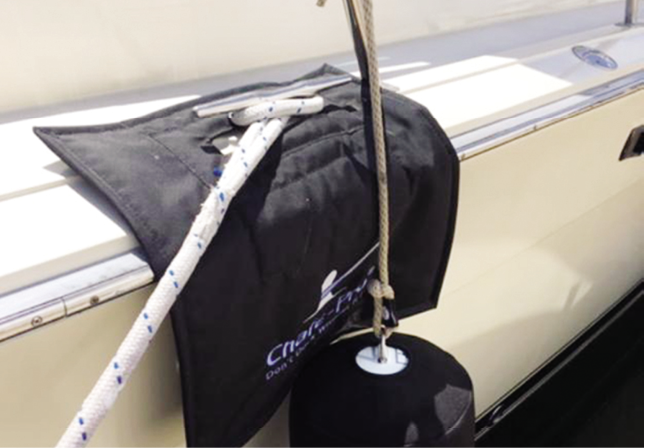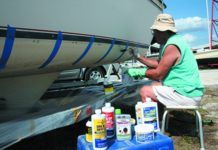Many sailors only visit the boat in fair weather and light winds, and they don’t know the mischief their berthed boat is up to in strong conditions. Visit your boat in a gale to observe how the dock lines are working, as well as whether the halyards are pinging, annoying others and potentially chafing or damaging the mast.
Halyards – If it’s slapping, even in the middle of the night, this is the time to fix it. Simple solutions include securing the halyard to a point away from the mast, or using a strop to tension the halyard away from the mast. Don’t use a bungee; it will help in light winds, but when it blows hard, the halyard will whip around with even more with rubber in the system.
Internal Halyards – Mast prebend tucks halyards against the aft side of the mast or to one side of a chamber in the mast, preventing pinging. Adjust the tension to stop the pinging.
Mast Electrical Wires – Normally, mast wires are installed inside conduit to prevent pinging, as well as to prevent them from tangling with halyards and to protect them from chafe. Sometimes foam “butterflies” are used to secure loose wires, although these don’t last long or work very well. Having conduit installed aftermarket, not uncommon, is typically $600-$1,000. An endoscope is probably the only practical way to figure out what you’ve got (see “Remote Inspection Cameras,” PS April 2021).
Wind Generator – Tie it down or otherwise disable it at the dock, and use either shore power or a single, small solar panel instead. You may be used to it, but the constant whine is annoying to your neighbors. This will also reduce wear and tear.
Riding Sail Back-and-Fill – Single-luff riding sails will occasionally tack, catching the wind on the reverse side with a “wump.” The sound repeats a minute or two later, when the boat tacks back. The cycle may repeat within minutes, or not for an hour. The cure is a V-style riding sail that cannot be backed (“Rest Easy with a Riding Sail,” PS August 2019).
Squeaky Ropes. Older lines stiffen as a result of UV damage, accumulation of lime and other salt, internal chafe, and loss of spinning lubes. We can’t fix the damage, but we can remove the lime with a good wash, and replace the spinning lubes with a durable water repellent (see “What’s the Best Way to Clean a Marine Rope,” PS August 2011, and “Aftermarket Cordage Treatments,” PS December 2011).
Add spring lines – Adding these essential lines to the slip or bulkhead reduces noise by reducing movement. You may have one spring, but as many as four will help (see “Spring Lines for Storm Preparedness,” PS August 2016).
Noisy Chafe Gear – Old ropes squeak in chocks. Rubber hose and leather provide effective protection, but they are also squeaky. Try switching to tubular nylon climbing webbing (very good, available in 1-inch and 2-inch widths) or Chafe Pro Tubular Sleeves (best).
Fender Squeak – Fender covers help, but if you don’t change them frequently, they attract growth and become abrasive. Adjusting spring lines can reduce fore-aft movement. On smaller boats, polyester dock lines can cause a jerky motion (change to nylon).
Transom Slap – Sure it can look silly, but a pool noodle tied across the transom at the waterline has been known to quiet the counter stern.
Junk on Shelves Shelf liners, replaced in a timely manner to prevent mold buildup, can reduce thumping. Smart packing helps; store a few washcloths and sponges with noisy items.






































Any thoughts on using three cable ties every couple feet on mast electrical wires inside a mast? In a mast where adding conduit is difficult (mine) the tails of the ties stop the wires slapping against the inside of the mast. The only downside I know of is that if there’s a need to remove/replace the wire later, one can’t pull the wire through any holes in the mast because the ties will stop it–it has to be pulled out an end of the mast.